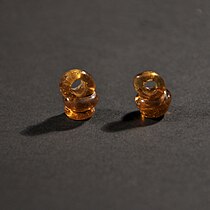Ivory Bangle Lady
| Ivory Bangle Lady | |
|---|---|
| Created | late 3rd-4th century AD |
| Period/culture | Roman |
| Discovered | 1901 Sycamore Terrace, York, North Yorkshire |
| Present location | Roman Gallery, Yorkshire Museum, York |
The Ivory Bangle Lady is a skeleton found in Sycamore Terrace, York in 1901.[1] She was a high-status adult female, of North African descent, who died in York in the 4th century AD.[2] Her skeleton was found with bracelets, pendants, earrings, beads as well as a glass jug and mirror.[3] She appears to have originally been from North Africa.[4] A piece of bone inscribed with the words, “Hail, sister may you live in God” was found with her skeleton.[5][6]
Skeletal remains
A 2010 research paper studied the skeletal remains of the Ivory Bangle Lady, which were found within a stone coffin. This research showed that the skeleton is of a young adult female, aged 18-23 years. Her height was calculated using regression analysis of her limb-bone length to be approximately 152–160 cm. Significantly, this research also used FORDISC to identified the Ivory Bangle Lady as having North African ancestry. This conclusion was reached following craniometric multivariate analyses, including measuring Mahalanobis distance, which suggested a strong affinity with two reference populations of African-American females from the 19th and 20th Centuries. Isotope analysis of oxygen and strontium isotopes suggest that she spent her childhood in the west of Britain or in coastal areas of Western Europe and the Mediterranean.[7] However, a 2009 study found that FORDISC 3.0 "is only likely to be useful when an unidentified specimen is more or less complete and belongs to one of the populations represented in its reference samples", and even in such "favorable circumstances it can be expected to classify no more than 1 per cent of specimens with confidence."[8]
Immediately after the publication of this research and its discussion in the press the Ivory Bangle Lady became a focal point of a debate about immigration in the past, with public discussions focusing on her racial identity. Notably, the comments on the online publication of a Daily Mail article highlighted a backlash from readers.[9] Emily Hanscam, in a 2019 article, compared this to the criticism aimed at Mary Beard in 2017 for defending the inclusion of a Black army officer in a BBC cartoon.[9]
Grave goods
The Ivory Bangle Lady was buried wearing ivory and jet bangles, a bracelet of blue glass beads, silver and bronze pendants, two yellow-glass earrings. A small, round glass mirror, a dark blue glass flagon, and an openwork, ivory inscription plaque were also included in the grave.[1] The plaque reads SOROR AVE VIVAS IN DEO ("Hail sister, may you live in God"), which is evidence for a Christian population in late Roman York. Whilst the plaque is clearly Christian, the existence of other grave goods and the alignment of the grave in a north-south (rather than east-west) arrangement strongly suggests that the lady interred was pagan, but had connections with a Christian community rather than herself being a Christian.[10]
-
Blue glass flask
-
Glass mirror
-
Glass beads
-
Earrings
-
Silver pendant
-
Inscribed bone plaque
Public display
The skeleton and grave goods are on display together in the Yorkshire Museum. In the 1980s the grave goods were on display as part of an exhibition titled "Roman Life at the Yorkshire Museum".[11] It is currently on display in an exhibition title 'Roman York - Meet the People of the Empire'.[6] The exhibition opened in August 2010 following the refurbishment of the Museum.[12]
In 2012 the Ivory Bangle Lady was the focus of a pilot project by Heritage Sandbox which used Twitter to augment the exhibition with new content.[13][14]
See also
References
- ^ a b "Burials". An Inventory of the Historical Monuments in City of York, Volume 1, Eburacum, Roman York. Royal Commission on Historic Monuments England. pp. 67–110.
- ^ "Roman era York may have been more diverse than today". phys.org. Retrieved 26 March 2019.
- ^ "Roman remains are 'elite' African". 26 February 2010. Retrieved 26 March 2019.
- ^ "Our Migration Story: The Making of Britain". www.ourmigrationstory.org.uk. Retrieved 26 March 2019.
- ^ Kennedy, Maev (26 February 2010). "African origin of Roman York's rich lady with the ivory bangle". The Guardian. ISSN 0261-3077. Retrieved 26 March 2019.
- ^ a b "Ivory Bangle Lady - Roman York - Yorkshire Museum". www.yorkshiremuseum.org.uk. Retrieved 26 March 2019.
- ^ Leach, S.; Eckardt, H.; Chenery, C.; Müldner, G.; Lewis, M. (2010). "A Lady of York: migration, ethnicity and identity in Roman Britain". Antiquity. 84 (323): 131–145. doi:10.1017/S0003598X00099816.
- ^ Elliott, Marina; Collard, Mark (11 November 2009). "Fordisc and the determination of ancestry from cranial measurements"". Biology Letters.
- ^ a b Hanscam, Emily (2019). "Postnationalism and the Past: The Politics of Theory in Roman Archaeology". Theoretical Roman Archaeology Journal. 2. doi:10.16995/traj.370.
- ^ Mawer, C. F. Evidence for Christianity in Roman Britain: The Small Finds. BAR British Series 243. Tempus Reparatum. p. 86.
- ^ Hartley, E. (1985). Roman Life at the Yorkshire Museum. Yorkshire Museum. p. 24. ISBN 0905807022.
- ^ Wuyts, Ann (2 March 2010). "Evidence of 'upper class' Africans Living in Roman York". The Independent. Retrieved 17 April 2019.
- ^ Knüsel, Christopher; Leach, Stephany Leach. "The Ivory Bangle Lady". HeritageSandbox. Retrieved 17 April 2019.
- ^ "Mystery lady who began tweeting from beyond the grave". Yorkshire Post. 28 September 2012. Retrieved 17 April 2019.






